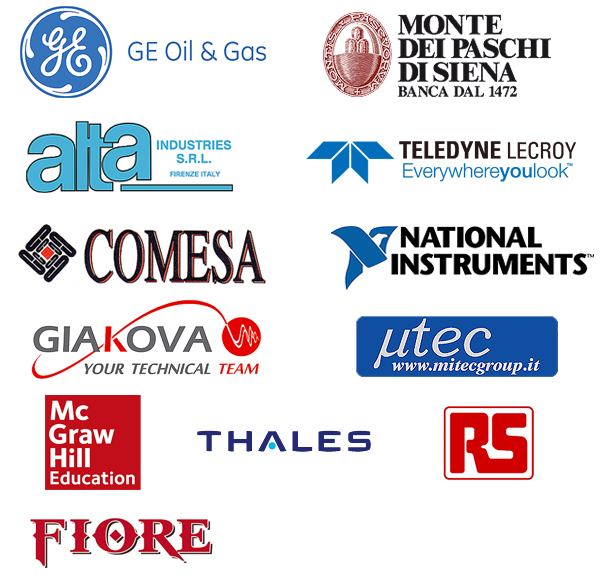Location
Complesso San Niccolò
c/o Dipartimento di Ingegneria dell’Informazione e Scienze Matematiche
Via Roma 56
PhD School program
The school workload is quantified in 4 Credits. Students attending the school will receive an individual attendance certificate. Multiple “Questions & Answers” tests will be organized to certify the credits acquisition.
PROGRAM OVERVIEW
The Optical Solution in Biosensing
Francesco Baldini, IFAC – CNR
Chemical and biochemical sensing is under the extensive research all over the world and many chemical and biochemical sensors are finding increasing number of applications in industry, environmental monitoring, medicine, biomedicine and chemical analysis. In recent years, the importance of optics in the biomedical area has been increasing owing to the advent of nanophotonics, which is opening completely new perspectives. In this lesson the fundamental basis of chemical and biochemical optical sensing are summarized and the new trends in biophotonics are described.
Biosensing technologies: examples and applications
Agnese Magnani, University of Siena
The recent development of biosensors for human pathogens and tumor markers as early detection of infections and cancer diseases management is of prime interest, so as to overcome the delay in diagnosis, health hazard and guarantee environmental safety. The advantages of biosensors over existing diagnostic methods are presented and various techniques and different immobilization matrices, used for their construction, are discussed together with their analytical performances both for medical diagnosis and environmental risks prevention.
Sensor Technologies to Support the IoT Evolution
Luca Roselli, University of Perugia
IoT is a very common buzzword. A strong debate is going on about what IoT actually is. In this seminary some IoT constraints will be touched including the multidisciplinary nature of IoT; then the enabling technologies will be described. In a second part, the importance of sensor development and of the constraints posed by IoT to the development of such sensors will be outlined. Some preliminary prototypes, as examples of the peculiarities of sensors for IoT, will be eventually shown. Everything will be treated to stimulate exercise of fantasy, that hopefully starts during the Q&A time.
Sensor Applications for monitoring, diagnostic and testing for turbomachinery
Stefano Cioncolini, GE Oil & Gas
Oil & Gas business requires large plants where natural resources like Oil and Natural Gas are extracted and delivered to the users. Outages and inefficient operating conditions can procure large losses of production and money. The development of these machines requires validation test with sophisticated sensors and when the machines are in operation. The lesson provides the description of monitoring techniques and special sensors able to measure parameters needed for the validation test, and the advanced sensors able to monitor with minimum invasiveness the operating condition on field.
Electronic Circuits and Techniques for Acoustic-Wave and Resonant Sensors
Vittorio Ferrari, Marco Ferrari, University of Brescia
The lecture is divided in two parts. The first part introduces acoustic waves as matter vibrations in elastic media and their application in sensors, with particular reference to resonators based on the piezoelectric effect for sensing different quantities. The second part presents advanced electronic circuits and contactless interrogation techniques for accurate detection and tracking of the resonant frequency and quality factor of acoustic-wave and resonant sensors, with main focus on mass-microbalance devices. Applications in different fields will be discussed.
Ultrasonic Transducers and Systems for Biomedical Applications
Piero Tortoli, University of Florence
After a brief historical overview of the major past developments in the field of medical ultrasound, the main characteristics of piezoelectric/CMUT transducers and of the associated ultrasonic fields are reviewed. The architecture of electronic scanners is then described, and details of the transmit, receive and acquisition circuits will be reported. The last part of this lecture is dedicated to the processing section and to the main, Imaging and Doppler, applications of such scanners. An analysis of the state-of-the-art and of the correlated perspectives concludes the presentation.
Smart CMOS imagers for 2D and 3D vision
Ricardo Carmona Galàn, Institute of Microelectronics of Seville (CSIC)
CMOS technology combines photon sensing and signal processing on the same substrate. This has led to the camera-on-a-chip concept. In this seminar we will describe sensing structures and interface circuits for 2D and 3D imaging, and their limitations and possible sources of noise. We will review the architecture of CMOS image sensors, on-chip image processing schemes to speed up feature extraction, and how CMOS technology enables embedded artificial vision and real-time scene understanding.
Analog Front-End Circuits for Resistive / Capacitive Sensors
Giuseppe Ferri, University of L’ Aquila
The presentation has the aim to give an overview on analog front-ends, describing solutions for the design of electronic interfaces suitable for resistive and capacitive sensors. After a description of the main interface parameters, several solutions are presented, most of which do not require any calibration. These solutions are different according to the entity of sensor variations, can utilize either AC or DC excitation voltages for the employed sensor and are developed in Voltage-Mode as well as in Current-Mode approach.
Look Inside the National Instruments Semiconductor Test System
Riccardo Susini, National Instruments
The PXI-based NI Semiconductor Test System (STS) combines modular instrumentation and system design software for RF and mixed-signal production test. This compact design eliminates the extra floor space, power, and maintenance required by traditional ATE testers that unnecessarily increase the cost of test. Additionally, with the open, modular STS design, you can take advantage of the latest industry-standard PXI modules for more instrumentation and computing power.
Signal Integrity: Jitter Measurement and Analysis
Maurizio Mastrofini, Teledyne LeCroy
The increasing rate in modern transmission systems, both optical and electrical properties, requires an accurate characterization of the total jitter and its main components. The need to ensure links with the lowest bit error rate (BER) requires the ability to design devices with the lowest content of jitter. Knowing how to wisely reduce the contribution of Rj*, Dj, DDJ, ISI, DCD, and more, allows to realize new projects in a safe and effective way.
Sponsored by
